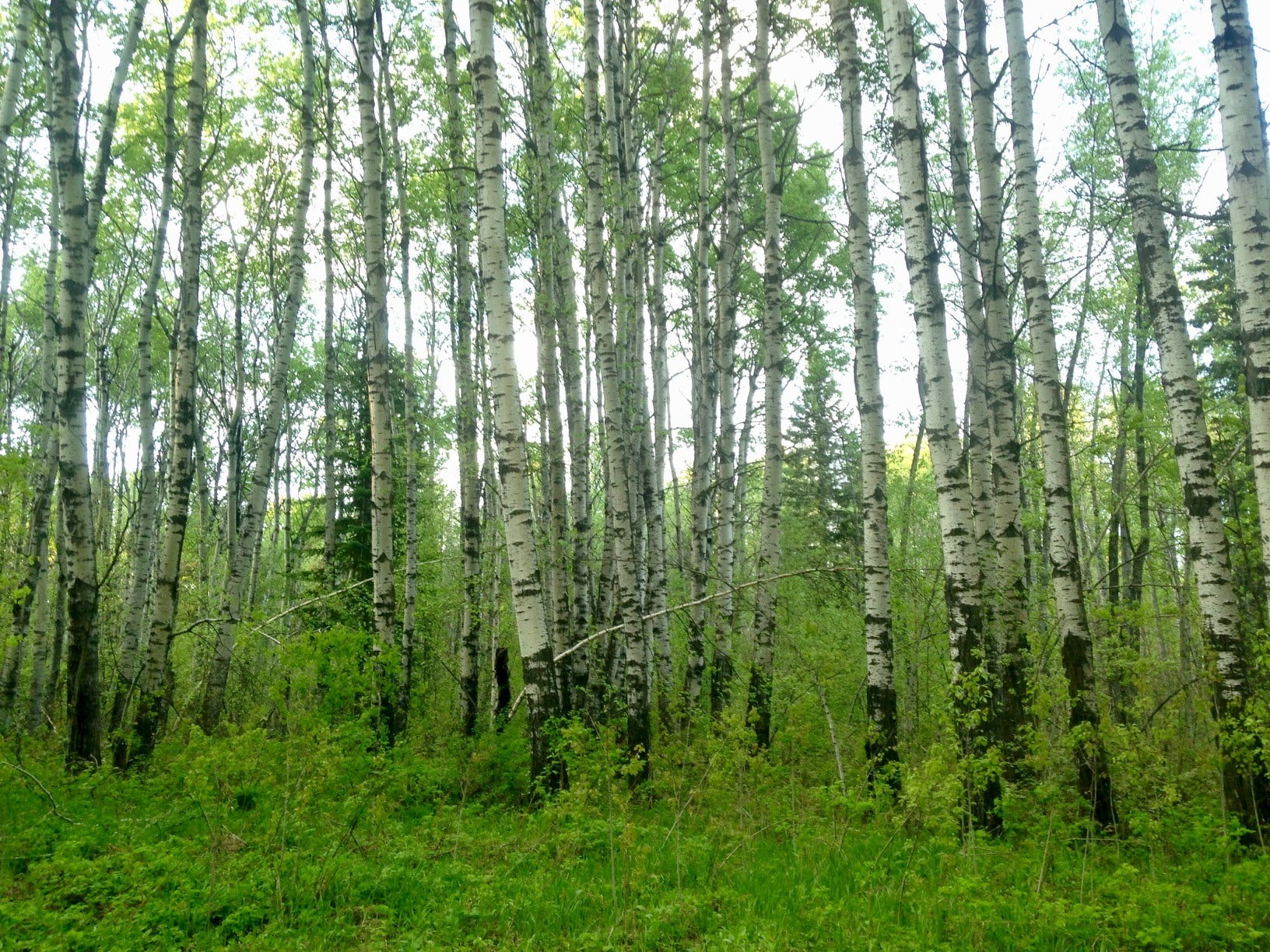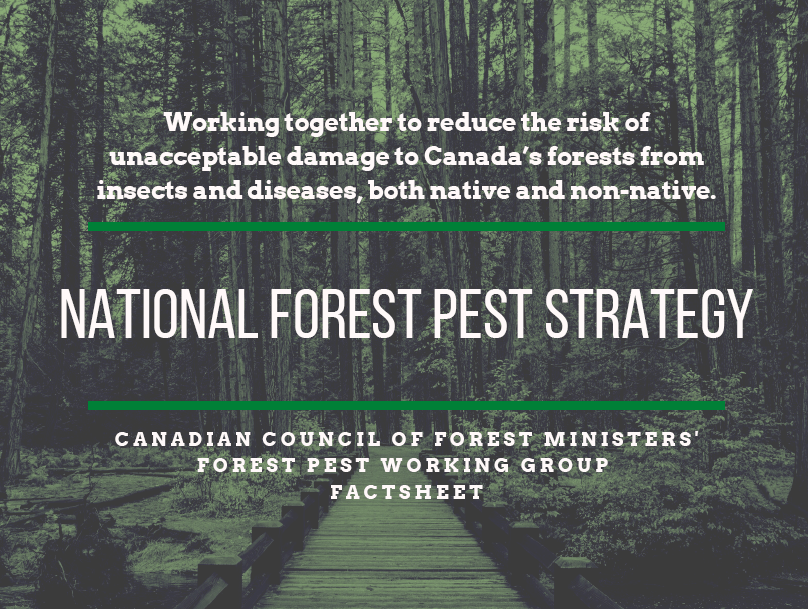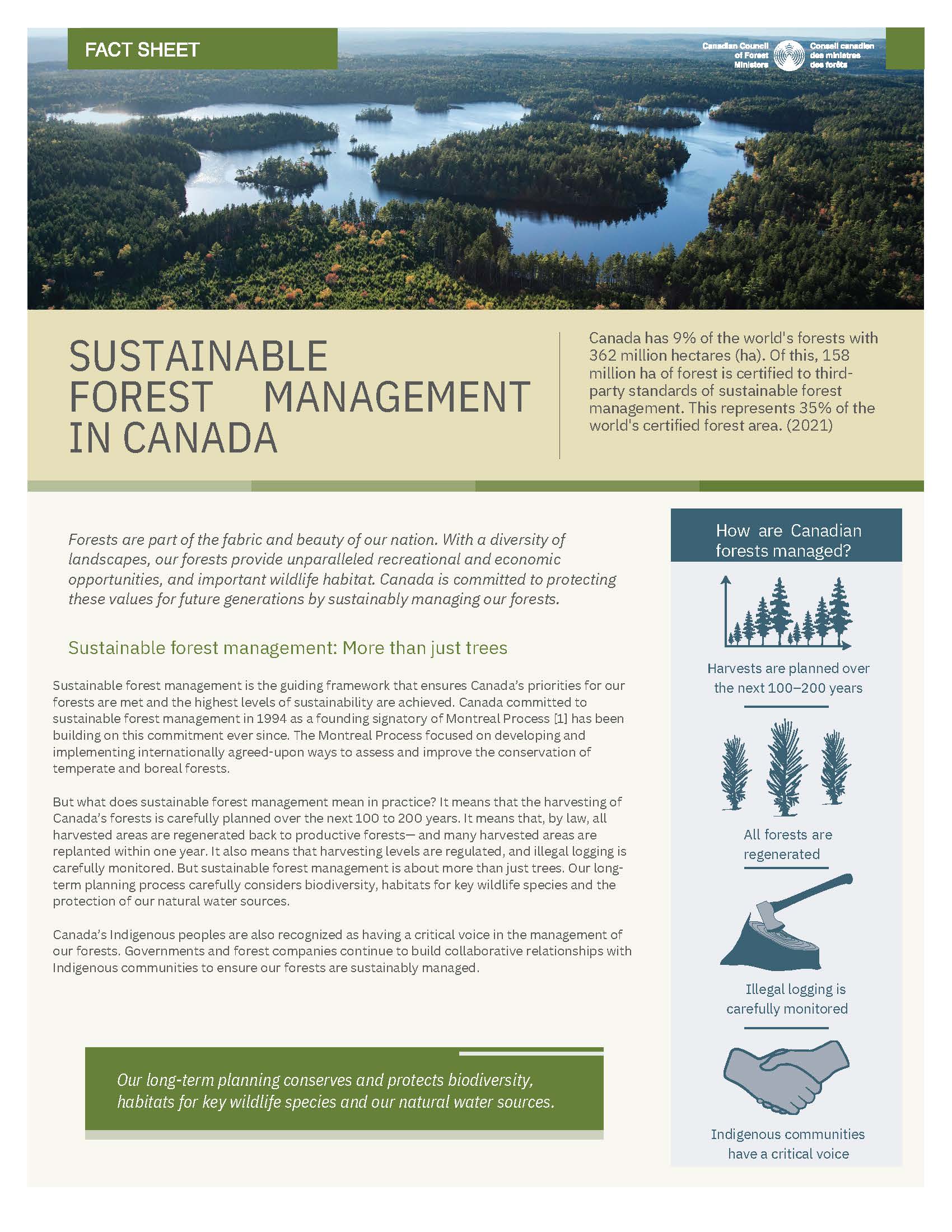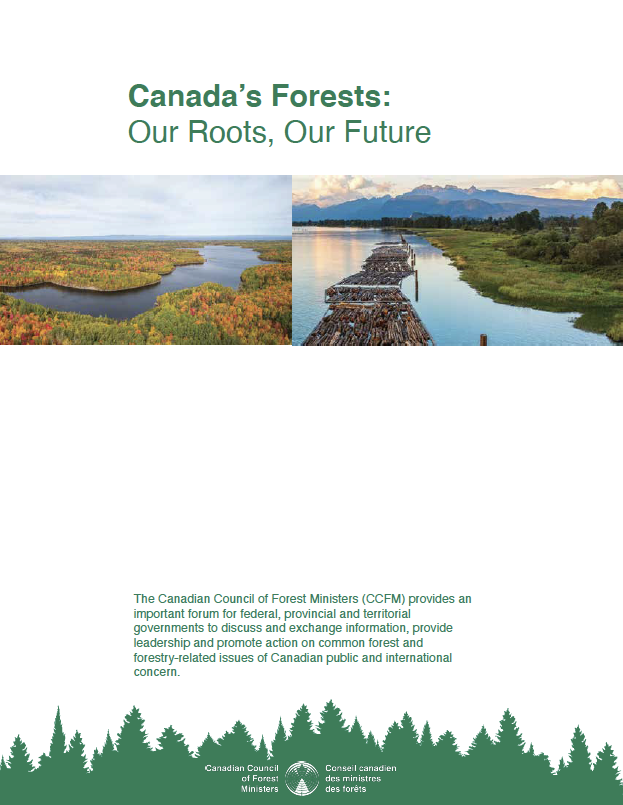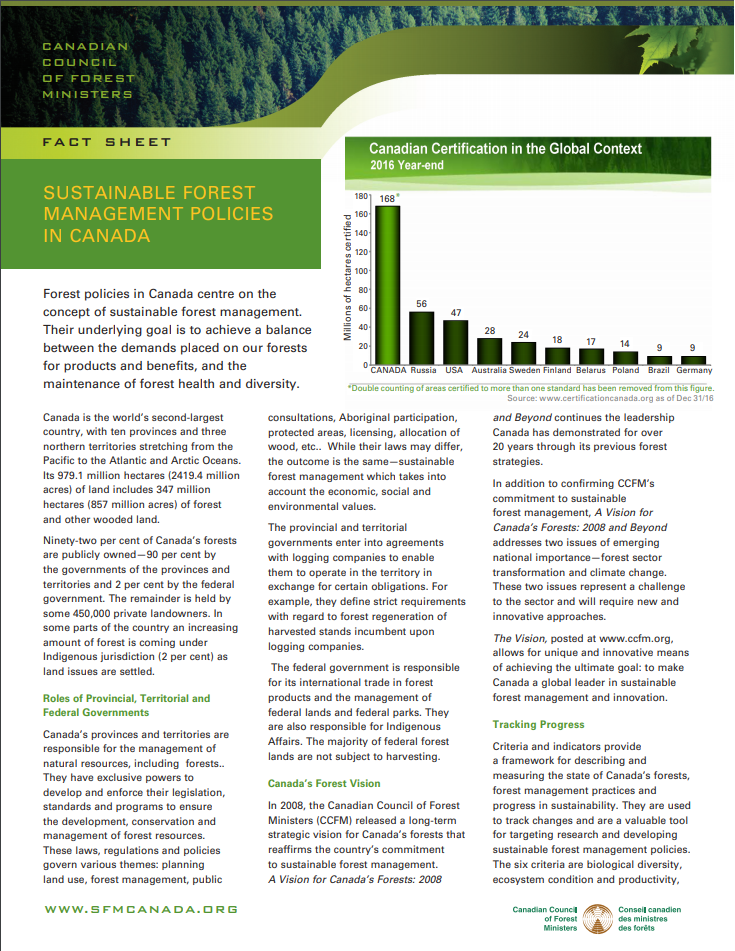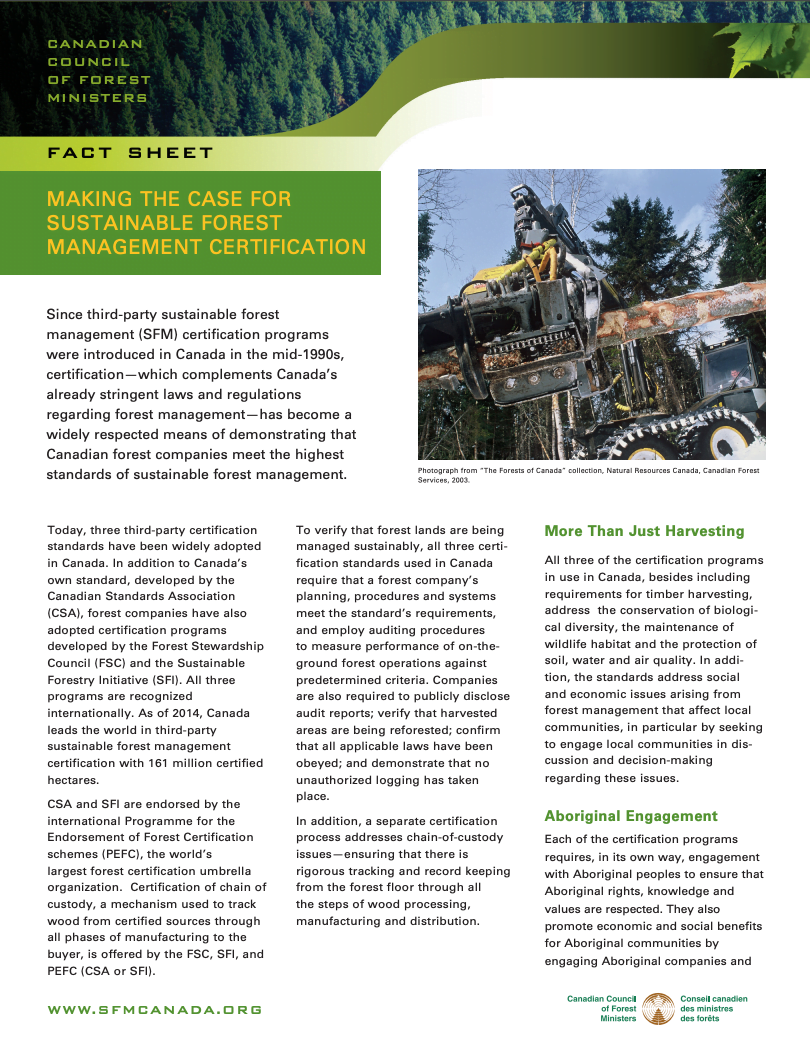Sustainable forest management (SFM) standards and practices
Managing Canada’s forests responsibly and sustainably means recognizing the close interconnections between the environment, economy and social well-being, so that the needs and expectations of all forest users might be met today and in the future. This “triple bottom line” is what underscores SFM in Canada.
Careful monitoring demonstrates sustainability
Because of their importance, Canada’s forests need to be carefully monitored to ensure that any challenges to their health are addressed. Canada recognizes the need to balance in a holistic way the demands placed on its forests, so that current and future generations of Canadians can fully benefit.
As a member of the Montréal Process, an international working group of 12 northern and southern hemisphere nations committed to SFM, one of the first tasks was to develop and implement internationally agreed-upon criteria and indicators for conservation and sustainable management.
The Montréal Process framework consists of seven criteria and 54 indicators, and has been implemented across the 12 member countries at a range of scales from local forest management units to regional, national, and even international levels. Since 1995, the Montréal Process member countries have used this common set of science-based criteria and indicators to measure progress toward the conservation and sustainable management of 90 per cent of the world’s boreal and temperate forests. In 2019, two new sustainability indicators were introduced to measure progress: forest area within protected areas and forest area with long-term management plans.
Together with information contained within statistical profiles, sustainability indicators are helpful tools to assess Canada’s forests and the benefits they provide, reveal the state of and trends in Canada’s forests and forest practices over time, highlight any needs for improvement in forest management policies and practices and supply reliable information for discussions and initiatives related to environmental performance and trade. The indicators also show the complexity of SFM, particularly in the face of climate change and other emerging issues.
These indicators are comparable to sustainability indicators published by other countries participating in the Montréal Process. Canada also uses some of these indicators to report on the United Nations Sustainable Development Goals.
Best practices in sustainability monitoring
The State of Canada’s Forests: A Global Comparison, a research study conducted by the University of British Columbia’s (UBC) Faculty of Forestry, used key measures to determine how forest practices in Canada compare with seven countries participating in the Montréal Process Criteria and Indicators.
Sustainable forest management is a clear priority in Canada. The peer-reviewed study found that Canada is a global leader in sustainable forest management, with some of the world’s most stringent forest management legal and policy frameworks at national, provincial and local levels. The research demonstrates that the forest management and conservation regime in Canada, within the study’s domains (i.e. legal framework, management plans, national forest inventory and reporting, and stakeholder involvement) is one of the most advanced in the world.
Collaborative data collection
Continuous improvement of environmental performance, as informed by science, is key to developing our resources responsibly, sustaining local communities as well as international trade and jobs. Collaborative data collection initiatives between the federal, provincial, and territorial governments, such as the National Forestry Database, help ensure consistent national data are available to support reporting on these and other indicators. This, in turn, helps support science-based decision making, research and program delivery.
Legal framework
Under Canada’s Constitution, the federal and provincial/territorial governments have specific roles in the management of public forest lands.
The federal government is responsible for matters relating to the national economy, trade, international relations, and federal lands and parks, and has constitutional, treaty, political and legal responsibilities for Indigenous peoples.
The provincial and territorial governments have legislative authority over the conservation and management of the forest resources on Crown lands. The laws and regulations governing forest practices on provincial and territorial public lands are among the most stringent in the world.
Third-party certification
Independent forest certification provides a stamp of approval showing customers they are buying products that come from forests managed to comprehensive environmental, social, and economic standards. A certificate is issued only after a thorough review by third-party auditors determines, among other things, that long-term harvests are sustainable, there is no unauthorized or illegal logging, wildlife habitat is preserved, and soil quality is maintained.
Voluntary forest certification standards complement forest management legal frameworks.
There are three major forest management certification systems in Canada. They complement our laws and regulations and ensure that a forest company is operating legally, sustainably and in compliance with world-recognized standards.
- Forest Stewardship Council (FSC)
- Programme for the Endorsement of Forest Certification – Canada (PEFC Canada)
- Sustainable Forestry Initiative (SFI)
They are tailored to consider global forestry issues as well as circumstances specific to the Canadian landscape, such as the livelihood of local communities and the interests of Indigenous people.
The CCFM recognizes FSC, PEFC Canada and SFI as being consistent with national and international agreements related to SFM and meeting criteria for balancing interests, being objective and science-based, implementable, and practical.
Forest regeneration
Regeneration activities ensure that harvested areas regrow as forests and continue to produce timber and maintain ecosystem services, such as storing carbon, regulating water quality, and providing habitat. The method used for regenerating forests can influence forest composition over time. Forest type, harvesting method and desired composition of the new forest determine the regeneration method (natural or artificial).
In the context of climate change adaptation, tree planting allows for the control of species composition and thus can be a tool to regenerate forests that may be better adapted to future climate conditions. Artificial regeneration — planting or seeding — has been applied to 60 per cent of the area harvested in the past 20 years; almost all of the remaining area is naturally regenerated.
Sustainable harvesting
Forests all over the country are harvested sustainably. Across Canada, all forests harvested on public lands must be regenerated — it is the law. This ensures that forests remain healthy and that the forest industry can continue providing Canadians with benefits.
This law is the reason that a disproportionately high percentage of the world’s certified sustainably managed forests are in Canada.
Although Canada is home to nine per cent of the world’s forest, it is also home to approximately 40 per cent of the world’s certified sustainably managed forests.
Ensuring sustainability over the long term
Provincial and territorial governments are responsible for forest management because the vast majority (about 88 per cent) of Canada’s forests are located on provincial and territorial Crown lands.
These governments determine the annual level of harvest allowed on a particular area of Crown land, called the allowable annual cut (AAC).
Because Crown lands harvested for commercial timber must be regenerated, either naturally or by planting and/or seeding, each province and territory has implemented regeneration standards and regulations. The standards address various aspects, including species composition, density, and stocking levels.
Only an exceedingly small portion of Canada’s forest is harvested each year. Of Canada’s 50.4 billion cubic metres (m3) of standing wood volume, about 0.3 per cent (131.6 million m3) was harvested in 2022. In 2022, British Columbia accounted for approximately 36 per cent of Canada’s industrial roundwood harvest, followed by Quebec and Alberta.
Area harvested
Commercial timber harvesting is one of several indicators of the level of industrial activity in the forest sector. Harvesting of forests on Crown land, the source of most commercial timber, is regulated to provide a sustainable level of wood supply. The area of forest harvested each year is monitored to ensure that the level of industrial activity in Canada’s forests is sustainable over the long term.
For more information, see The State of Canada’s Forests Annual Report 2024: Areas Harvested (page 40).
Deforestation and afforestation
Forest loss affects biodiversity, soil, air and water quality, and wildlife habitat. Forests store more carbon than many other ecosystems and can be managed to help mitigate climate change. Canada’s low annual deforestation rate has declined even further since the 1990s, dropping from 64,000 hectares per year (hectares/yr) in 1990 to about 49,000 hectares/yr in 2022.
Natural Resources Canada and the Canadian Forest Service (CFS) have one of the world’s most sophisticated systems to monitor and track deforestation — the National Deforestation Monitoring System (NDMS). The NDMS tracks changes from forest land to other land uses across Canada. Deforestation does not include forest harvesting activities where the forest will be regrown.
For more information, see The State of Canada’s Forests Annual Report 2024: Deforestation and Afforestation (page 33).
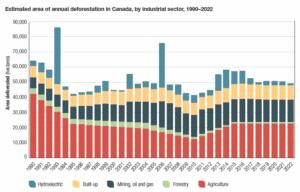
Volume harvested relative to the sustainable wood supply
Forest managers track the volume of timber harvested each year to ensure it falls within sustainable levels. Harvests from provincial Crown lands are regulated by allowable annual cuts (AAC).
Although there is no AAC calculation for Canada as a whole, it is possible to compare the combined provincial and territorial AACs with the combined harvest totals from the same Crown land base.
In 2022, Canada harvested 129.5 million cubic metres (m3) of industrial roundwood, well below the estimated sustainable wood supply* level of 213.6 million m3.
*Sustainable wood supply refers to the volume of timber that can be harvested from federal, provincial, territorial and private lands while meeting environmental, economic and social objectives.
Source: National Forestry Database.
For more information, see The State of Canada’s Forests Annual Report 2024: Volume Harvested Relative to Sustainable Wood Supply (page 45).
Forest in Mind
Forest in Mind (FMP) is a collaborative market intelligence and advocacy program of the CCFM supported by Canadian missions abroad to position Canada as a world leader in sustainable forest management and environmental stewardship to protect and enhance market access for Canadian forest products. The objectives of the program are to:
- Position Canada’s provinces and territories as environmentally responsible forestry jurisdictions, and that forest products from Canada are an environmentally friendly and renewable choice.
- Support Canada’s trade framework by promoting leading/best provincial and territorial forestry policies and practices, initiatives and achievements.
- Inform foreign government agencies in their development of policies that favour the use of Canadian forest products (e.g. procurement policies, building codes and policies, energy policies).
- Provide CCFM deputies and ministers with accurate and timely information and analysis on relevant international issues.
